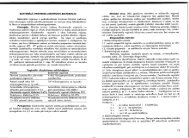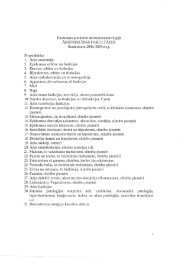PHYSICS
n - susliks.lv
n - susliks.lv
- No tags were found...
Create successful ePaper yourself
Turn your PDF publications into a flip-book with our unique Google optimized e-Paper software.
alveoli (fig. 6.10). The blood-epithelium-air interface<br />
of the lungs is very large and is approximately<br />
equal to the area of a tennis court. Changes of<br />
surface tension in the lungs are responsible for a<br />
respiratory disease in new born babies, called the<br />
hyaline membrane disease, which is characterized<br />
by the deposition of hyaline substance on the<br />
internal surface of the alveoli. The treatment of<br />
+-lOOlLm-. this disease is associated with the application of<br />
surfactants, species which are able to<br />
Fig. 6.10. A diagrammatic reduce surface tension at the blood-air<br />
cross-section of an alveole interface in the lungs.<br />
6.3.3. Capillarity<br />
A phenomenon caused by the surface tension at the interface<br />
of two nonmixing media is called capillarity and is observed when<br />
a distorted surface of a liquid leads to an elevation or depression<br />
of the liquid when in contact with a solid. It is necessary to take<br />
into account the effects of two opposing forces: adhesion, the<br />
attractive (or repulsive) force between the molecules of the liquid<br />
and those of the container, and cohesion, the attractive force<br />
between the molecules of the liquid. When the liquid-gas interface<br />
is curved, the resultant surface tension produces an additional<br />
pressure difference across the interface. For a hemispherical liquid-gas<br />
interface having radius of curvature R, the pressure<br />
difference is given by the Laplace equation:<br />
2· 0<br />
!:::"p = ±-<br />
R (6.22)<br />
where c is coefficient of surface of the liquid.<br />
If the interface is not spherical, the Laplace equation is:<br />
!:::"p = ±a .[_1_ + ~ J, (6.23)<br />
R 1<br />
R2<br />
where R] and R 2 are the radii of curvature of two perpendicular<br />
planes.<br />
The sign for Sp is positive for a concave interface and negative<br />
for a convex interface.<br />
58<br />
A cylindrical tube with a small internal diameter is called a<br />
capillary. The behavior of liquid in capillary is strongly modulated<br />
by the wettability of the tube walls. If the walls are wettable, the<br />
water rises in the capillary (fig. 6.11). For example, with water in<br />
xylem vessels, the attraction between the water molecules and<br />
the wall is great, causing the liquid to rise.<br />
To calculate the extent of capillary rise, the balance of two<br />
forces, gravity nr'pgh acting downward<br />
and surface tension Znrocosti,<br />
must be determined. Since these forces<br />
are balanced, the extent of rise<br />
h I I~~~t~~~ (h) is given by equating the two<br />
forces (nr 2pgh = 2nrcrcose), which<br />
leads to:<br />
h = 20 cos e<br />
(6.24)<br />
pgr<br />
Fig. 6.11. The fluid in<br />
a narrow tube is puJJed up<br />
by the additional pressure<br />
on the hemisphere at the<br />
liquid-air interface<br />
6.3.4. Capillary Rise<br />
where p is the density of liquid,<br />
e - the contact angle, g - the gravitational<br />
acceleration, r = Rcose <br />
the radius of capillary and R - the<br />
radius of surface curvature.<br />
Example. Ifaxylem vessel has a lumen radius of 20 11m, using<br />
equation 6.24, we can determine that water (the density at 20 0 e is<br />
998.2 kg/rn-, surface tension is 0.0728 N/m) will rise to the following<br />
height:<br />
h = 2u cos e = 2·72.8 ·10-' N . m- I cos 90° = 1.49.10- 5 m 2 = 0.745 m<br />
pgr 998.2kg·m 1· 9 .8m · s 2·20·1O- 6m 20·1O- 6(m)<br />
Such a capillary rise would be sufficient to account for the upward<br />
movement of water in small plants (:$; I m in height).<br />
59






